Christopher Martin Hoff (detail)
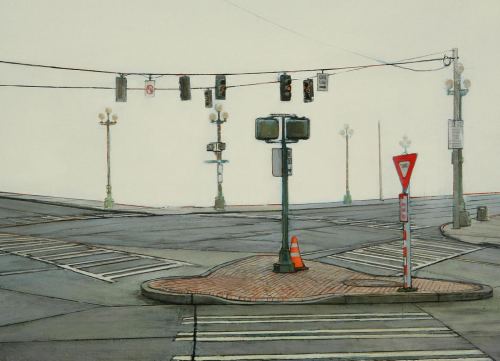
Regina Hackett takes her Art to Go
Christopher Martin Hoff (detail)

The problem with Michelangelo Public and Private: Drawings for the Sistine Chapel and Other Treasures from the Casa Buonarroti isn’t the core of the exhibit itself. Had the Seattle Art Museum stripped it of lard and presented it with the modesty it deserves, it would have been a fine thing to see in a small gallery on a rainy afternoon.
Instead, Michelangelo comes with the trappings of a major moment: a wall-sized time-line of the artist’s life, extensive text, copious illustrations and an attempt to create titillating controversy.
Flashing on the Web site:
Michelangelo burned most of his sketches. Come see 12 drawings that escaped the fire.
They escaped the fire but not their admirers. The Casa Buonarroti Web site explains why the drawings are ghostly. The best of the 200 in the collection were on view from 1566 to 1960 with no time out for good behavior. The Uffizi undertook their restoration, returning them 15 years later.
Surely the Uffizi is not responsible for what happened to a preliminary sketch for The Last Judgment. The wall label notes that the artist created it in black chalk, reinforced later with pen and ink. In other words, it’s an original traced into a forgery.
Make that 11 sketches. Still, they’re Michelangelo’s. Not for nothing did he regret his work when he was a pious old man, inclined to agree with the cleric Pietro Aretino that some of his nude figures would be “at home in some voluptuous bathhouse, certainly not the highest chapel of the world.”
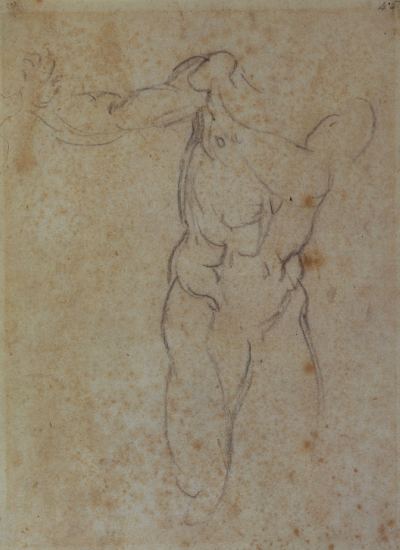 As a colorist Michelangelo was the equal of Raphael, and his forms have no peers.
As a colorist Michelangelo was the equal of Raphael, and his forms have no peers.
This show screams minor museum in a provincial town.
Painter Fred Einaudi opted for inclusion. If you click on biography on his Web site, you’ll get:
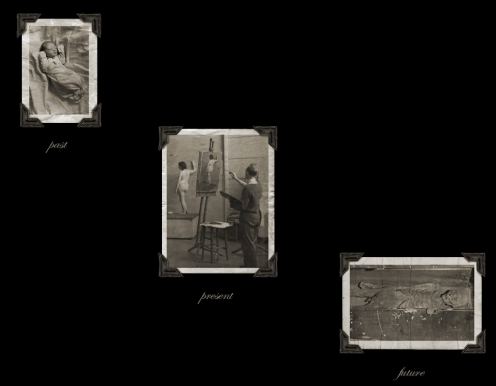 And nothing else. What else is there?
And nothing else. What else is there?
When cornered, Mary Ann Peters comes out drawing. Even when her resources are depleted and her imagination drained, she can count on the marks her hand makes. They’re beautiful, no question, but they’re also flaccid imitations of her work when it’s focused and intense. Allusions to remembered landscapes become allusions to upscale wine bars. I can imagine sitting beside one doing double duty as wallpaper as a waiter glides up to take my order.
and the edge becomes the center, 2009, Watercolor and gouache on clayboard, 96″ x 120″
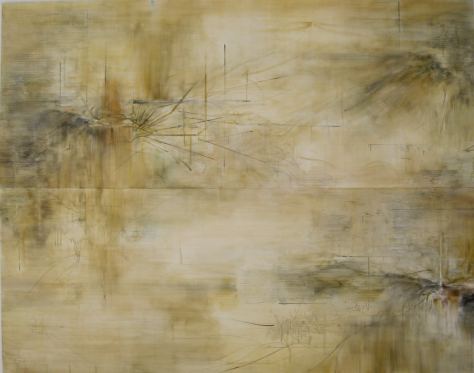 Besides the above painting, her exhibit at James Harris Gallery features a series of small drawings. They lack the turgid sense of empty overkill that ruined the painting, but even though fresher, they’re still Peters in a minor vein.
Besides the above painting, her exhibit at James Harris Gallery features a series of small drawings. They lack the turgid sense of empty overkill that ruined the painting, but even though fresher, they’re still Peters in a minor vein.
Her 2006 exhibit at the same gallery was superior in every way.
Through Nov. 14.
In the middle of the 19th century, painters thought of Victor Hugo as a writer, and writers called him a painter.
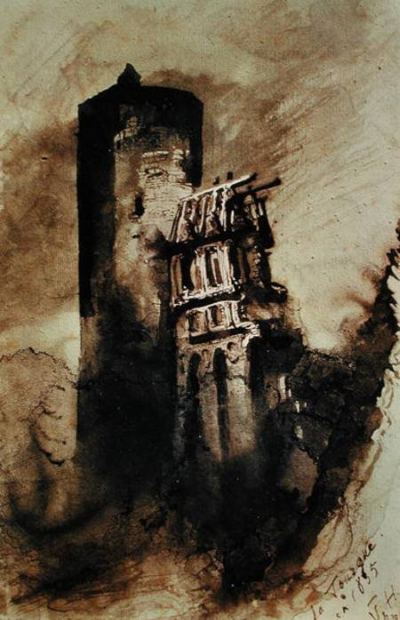 Now that few who are not forced read his famous novels (thick in every sense), his 1998 exhibit at the Drawing Center was decisive. Writers don’t claim him, but painters need to, as his connection in the visual realm is decisive. His semi-abstractions freely range from the specific to the general,
Now that few who are not forced read his famous novels (thick in every sense), his 1998 exhibit at the Drawing Center was decisive. Writers don’t claim him, but painters need to, as his connection in the visual realm is decisive. His semi-abstractions freely range from the specific to the general,
zeroing in and fading out, suggesting vast amounts of time crawling by
and smoke hanging amid ruins.
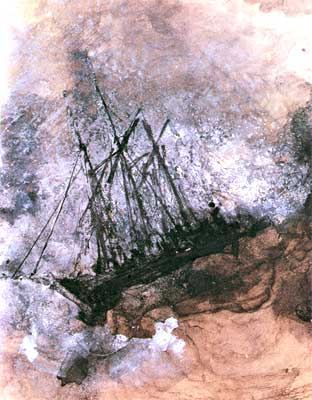 The link between him and certain painters of the present moment is the use of fine lines that cut through vapor to shovel smoke.
The link between him and certain painters of the present moment is the use of fine lines that cut through vapor to shovel smoke.
In Seattle, there’s Mary Ann Peters, now on view at the James Harris Gallery. (Images below from 2006 exhibit. Review of current one to follow.)
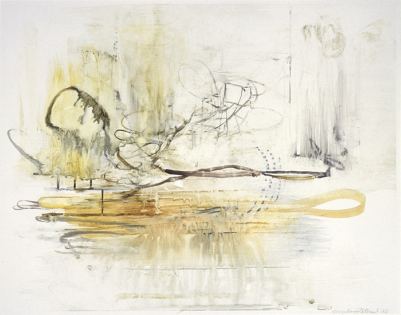
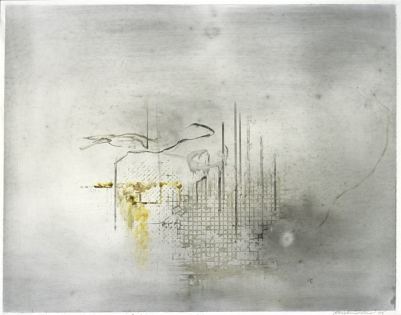 In San Francisco, Darren Waterston.
In San Francisco, Darren Waterston.
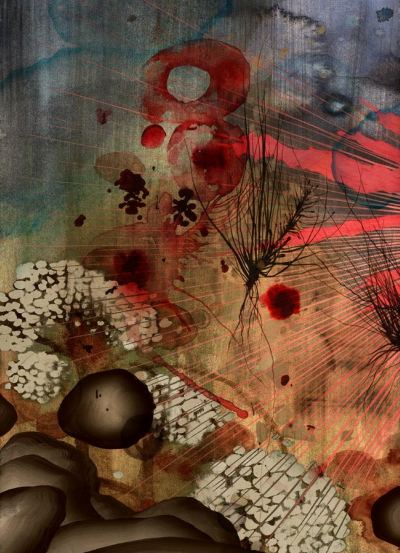 In New York, Christopher Lowry Johnson.
In New York, Christopher Lowry Johnson.
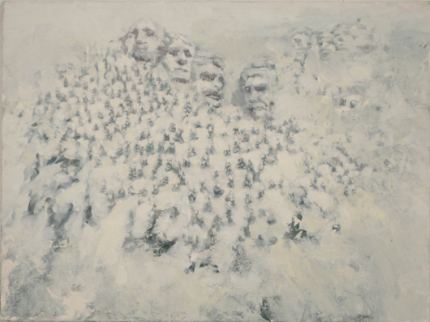 In LA, Tony De Los Reyes, at Howard House through Oct. 31.
In LA, Tony De Los Reyes, at Howard House through Oct. 31.
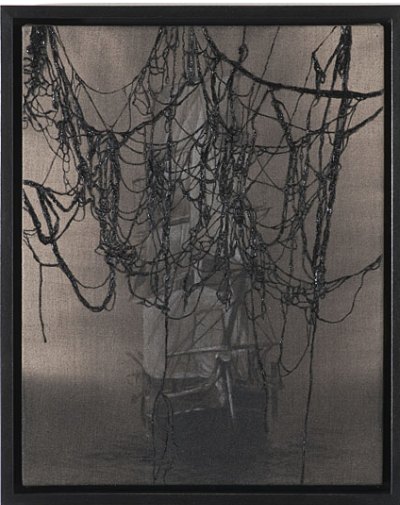 In LA and New York, Gary Simmons:
In LA and New York, Gary Simmons:
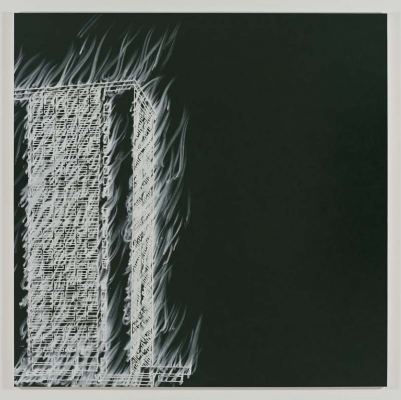 In New York and London, Cecily Brown.
In New York and London, Cecily Brown.
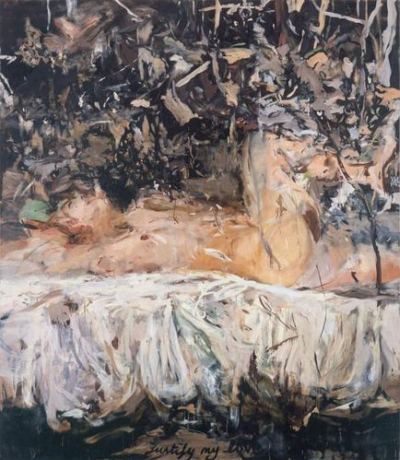 And two more from Seattle, Barbara Earl Thomas
And two more from Seattle, Barbara Earl Thomas
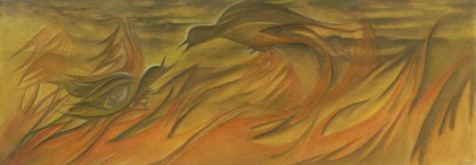 …and Kenneth Callahan, a drawing from 1972.
…and Kenneth Callahan, a drawing from 1972.
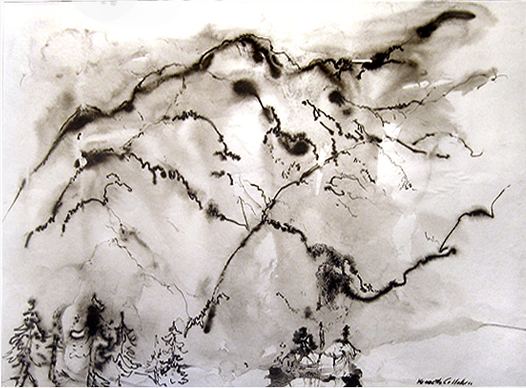
In response to this post, The Meat Dance, after Amiri Baraka, Sue Danielson suggested the addition of Pinar Yolacan. Excellent choice.
From Boing Boing:
Turkish-born artist Pinar Yolacan, who is based in Brooklyn, is best known for her portraits of ladies wearing clothes fashioned from meat parts (tripe, guts, assorted offal). (more)
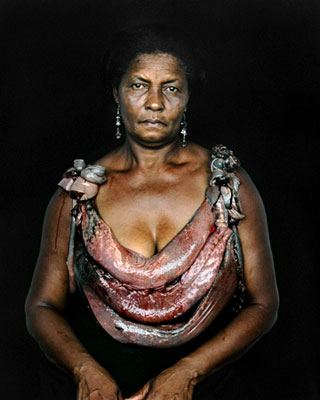
From Judson Church archive:
Meat Joy has the character of an erotic rite: excessive, indulgent, a celebration of flesh as material: raw fish, chickens, sausages, wet paint, transparent plastic, rope brushes, paper scrap. It’s propulsion is toward the ecstatic– shifting and turning between tenderness, wilderness, precision, abandon: qualities which could at any moment be sensual, comic, joyous, repellent.
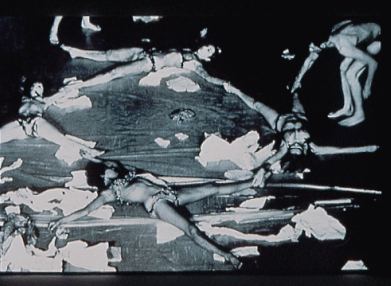 Zverina also offered his meat poem, titled, Holy Cow.
Zverina also offered his meat poem, titled, Holy Cow.
i don.t eat meat, do you?
it.s a really bad thing to do
cattle ranchers use public land
to fatten these beings for slaughter
this cruel business is subsidized
by your and my tax dollars
life is cruel, i know, it.s true–
it.s basically eat or be eaten
but if i come back as a cow,
it.s not yr mouth i want to be meat in
Ries Niemi suggested Ann Simonton.
Wrote Niemi:
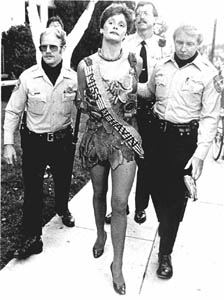 Thanks, everybody.
Thanks, everybody.
Like Thomas Demand, Oliver Boberg, James Casebere and Lori Nix,
Ross Sawyer Sawyers constructs models that he photographs as full-scale environments.
Demand’s are meticulous and devoid of oxygen. Boberg’s explore the homey banality of the ordinary. Casebere’s focuses on the ornate, often after a flood, and Nix’s are fantastical. Each manages to make worlds from doll-house stage sets.
Sawyers’ are constructed to look as if they are still under construction, and photographed as if they are melodies orchestrated with light.
Wrote Andrew Kozlowski in Art Papers, September/October, 2009:
These spaces recall unfinished housing developments and luxury condo projects abandoned by unscrupulous investors, ready to fall down at any moment.
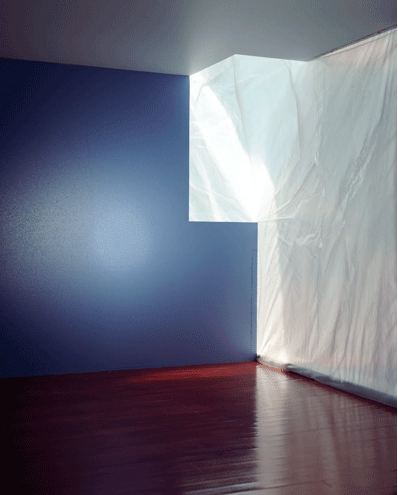
In the untitled photo above, the floor becomes liquid at it meets the white scrim, which extends to a rectangle that appears to be three-dimensional at the top and flat at the bottom. A full moon casts its reflection on the blue water, bringing to mind the seascapes Arthur Dove.
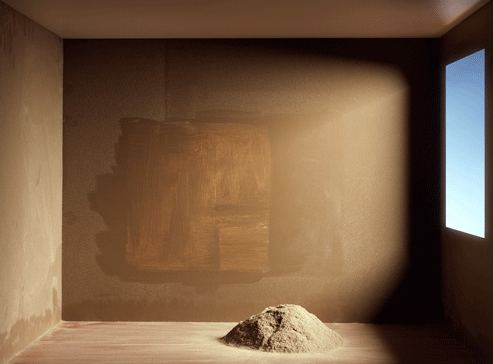 More toying with art history. Above, James Turrell meets Wolfgang Laib meets Rothko.
More toying with art history. Above, James Turrell meets Wolfgang Laib meets Rothko.
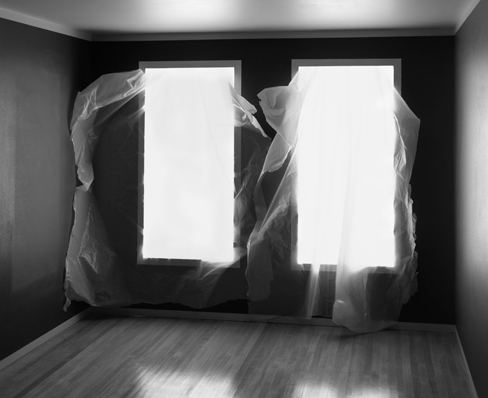 Above, light wrapped and ready with nowhere to go.
Above, light wrapped and ready with nowhere to go.
At Platform Gallery through Nov. 28.
From Michael Buitron of Leap Into The Void:
In my mid-residency review for my master’s at CalArts, I told Sam Durant that the things I was being evaluated on and expected to do for my mid-res show–make objects, install them in an aesthetically appropriate fashion, light the work, advertise it, talk about it, write about it, invite faculty, cater an opening reception–all amounted to CalArts being a finishing school to the social graces and conventions of the art world. “I would hope so,” was his response, “We don’t want you to leave here without those skills.”
He’d prefer not to. (more)
From Susanna Bluhm of Getting To Know You Better:
I would love to go on some kind of massive research expedition to explore this very question. I want to know details about how other artists are making ends meet and making things work. I don’t know if it’s for commiseration or inspiration, or purely because no one ever talks about it. It was an unmentionable even in my grad school program, this “how to survive” issue. Is it because you don’t? Or at least not by doing art? I’ve heard “There’s always teaching,” but really there isn’t. Teaching art at the college level is extremely competitive, and in order to get a stable teaching job, MFA graduates must first be willing to (typically) move anywhere in the country to adjunct part-time at near-poverty wages. (more)
How to get covered by a daily newspaper:
Step one. Create a blog. Step two. Without taking off your pajamas, announce a contest for cities with your results. The smartest. The sexiest. The greenest. The most fat. Publish your top ten and send a link to your targets. Newspapers fall for it. The most desperate put you on the front page. In the rush to get your survey into print, mistakes are made.
From Fail Blog:
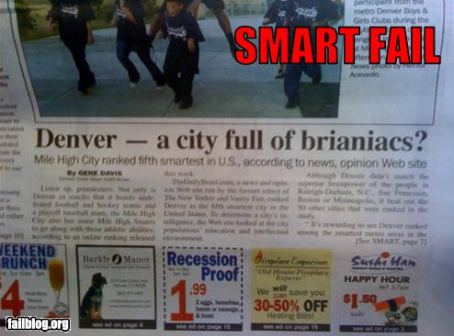
Good news after the fire: Less damage to Helio Oiticia’s life’s work than first reported.
From Greg.org:
Note to self, the Brazilian media & world’s wire services: the guy standing outside his burning house and saying he lost everything does not, in fact, know that everything is lost.
(more)
Gay kiss-in from O My God Seattle here. I love flash mob art, so evocative of earlier models.
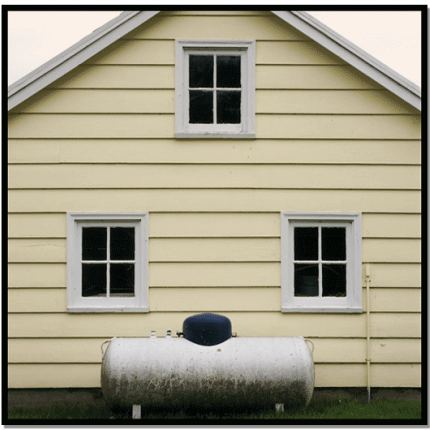 Louise Bourgeois, Femme Maison, 1947
Louise Bourgeois, Femme Maison, 1947
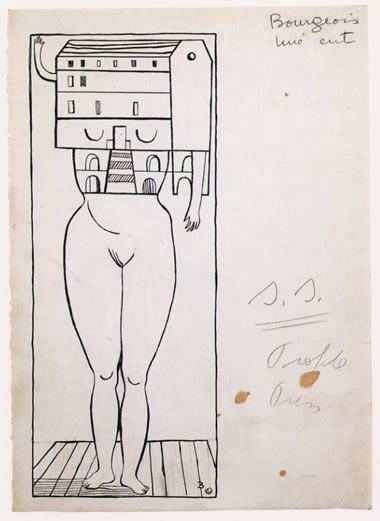 Janine Antoni (At Luhring Augustine through Saturday)
Janine Antoni (At Luhring Augustine through Saturday)
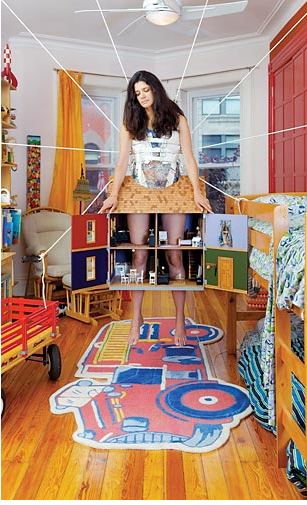 Alex Schweder, A Sac of Rooms Three Times a Day, currently in Sensate at the San Francisco Museum of Art, through Nov. 8.
Alex Schweder, A Sac of Rooms Three Times a Day, currently in Sensate at the San Francisco Museum of Art, through Nov. 8.
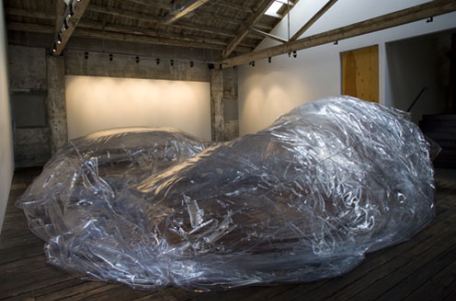 Barbara Noah, Earth As Bowling Ball
Barbara Noah, Earth As Bowling Ball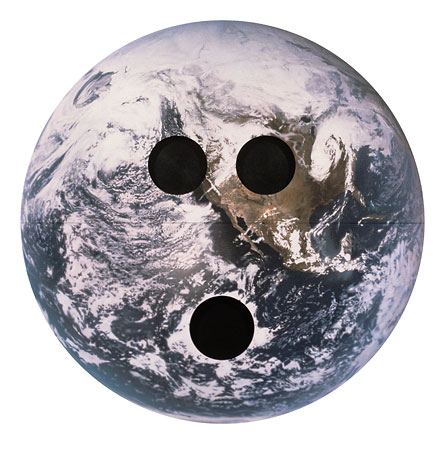
an ArtsJournal blog


